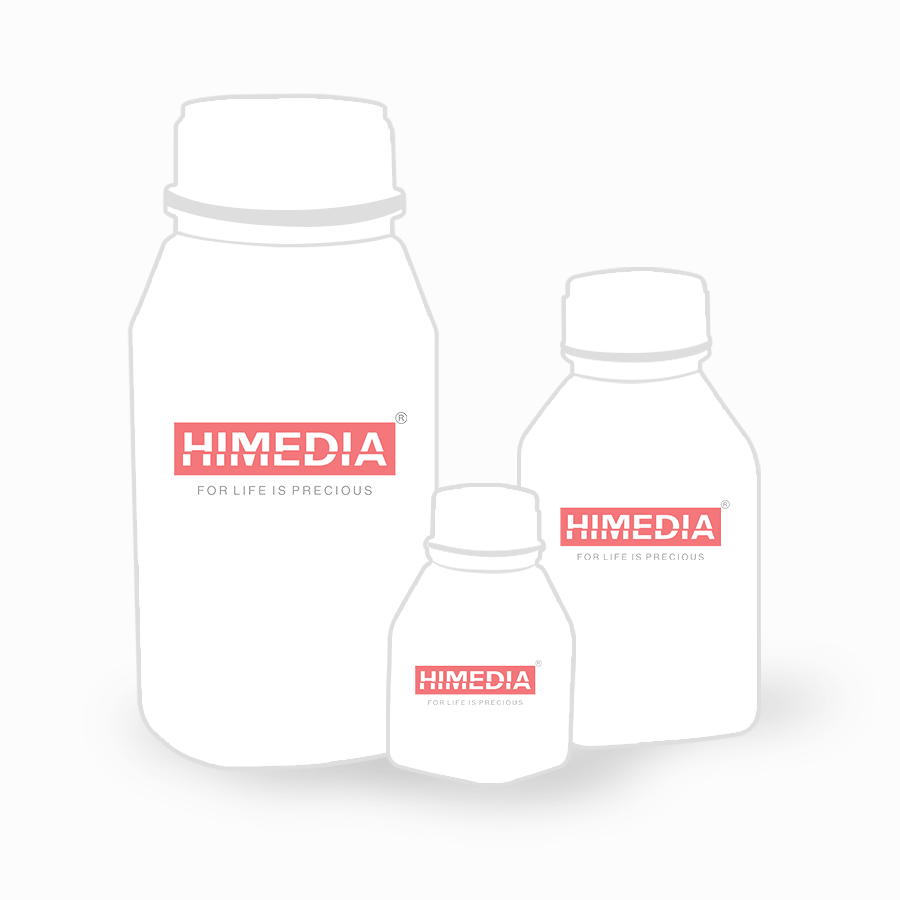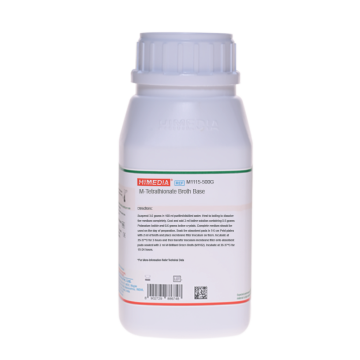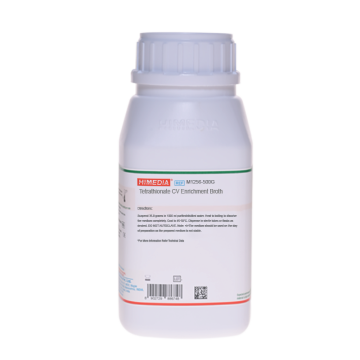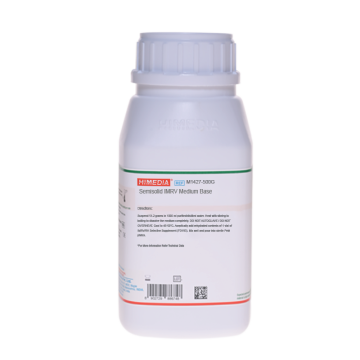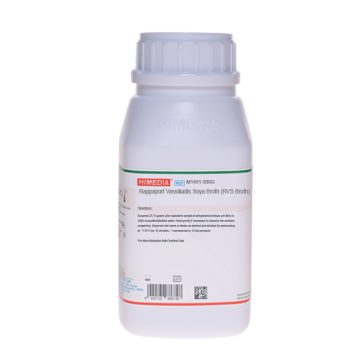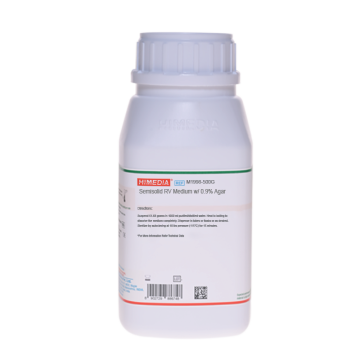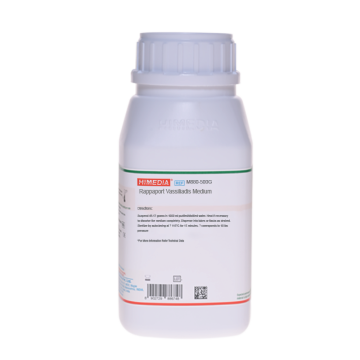 Your enquiry has been submitted
Your enquiry has been submitted
Mannitol Selenite Broth w/ Brilliant Green (Twin Pack)
Intended Use
Recommended for enrichment of Salmonellae from faeces, foodstuffs and other materials.
Composition**
| Ingredients | g/ L |
|---|---|
| Part A | |
| HM peptone # | 5.000 |
| Yeast extract | 5.000 |
| Sodium taurocholate | 1.000 |
| Brilliant green | 0.005 |
| Potassium dihydrogen phosphate | 3.400 |
| Dipotassium hydrogen phosphate | 4.350 |
| Mannitol | 5.000 |
| Part B | |
| Sodium selenite | 4.000 |
Final pH ( at 25°C): 7.0±0.2
**Formula adjusted, standardized to suit performance parameters
# Equivalent to Meat peptone
Directions
Suspend 4.0grams of Part B in 1000 ml purified/distilled water. Add 23.75grams of Part A. Mix well. If desired add 0.5g/L sodium sulpha pyridine, warm to dissolve the medium completely. Dispense as desired and sterilize in a boiling water bath or free flowing steam for 10 minutes. DO NOT AUTOCLAVE. Excessive heating is detrimental. Discard the prepared medium if large amount of selenite is reduced (indicated by red precipitate at the bottom of tube/bottle).
Principle And Interpretation
Selenite-containing media for the enrichment of Salmonella was first described by Guth (1). This medium was further modified by Leifson (2) for the enrichment and isolation of Salmonella from clinical specimens. Mannitol Selenite Broth w/Brilliant green is prepared as per the formulation of Stocks and Osborne (3). This medium is recommended for isolation or enrichment of Salmonella from small inocula. Also the strong buffering capacity of the medium prevents damage to cultures due to over-acidification when mannitol is fermented.
HM peptone and yeast extract provides amino acids and other nitrogenous substances to Salmonella. Mannitol serves as fermentable carbohydrate, a sugar alcohol which also helps in maintaining a uniform pH along with the phosphates. Phosphates also lessen the toxicity of selenite.
Do not incubate longer than 24 hours as the inhibitory effect of selenite is reduced after 6-12 hours incubation (4). Subculture broth from the upper third of the broth column to greater or lesser inhibitory selective agars.
Type of specimen
Clinical samples - Faeces; Food samples; Water samples
Specimen Collection and Handling
For clinical samples follow appropriate techniques for handling specimens as per established guidelines (5,6).
For food samples, follow appropriate techniques for sample collection and processing as per guidelines (7).
For water samples, follow appropriate techniques for sample collection, processing as per guidelines and local standards.(8)
After use, contaminated materials must be sterilized by autoclaving before discarding.
Warning and Precautions
In Vitro diagnostic Use. For professional use only. Read the label before opening the container. Wear protective gloves/protective clothing/eye protection/face protection. Follow good microbiological lab practices while handling specimens and culture. Standard precautions as per established guidelines should be followed while handling clinical specimens. Safety guidelines may be referred in individual safety data sheets.
Limitations
- Excessive heating is detrimental for the medium.
- Discard the prepared medium if large amount of selenite is reduced (indicated by red precipitate at the bottom of the tube).
- Do not incubate longer than 24 hours as the inhibitory effect of selenite is reduced after 6-12 hours incubation (4).
Performance and Evaluation
Performance of the medium is expected when used as per the direction on the label expiry period when stored at within the recommended temperature.
Quality Control
Appearance: Part A : Cream to pale green homogeneous free flowing powder Part B : White to cream homogeneous free flowing powder
Colour and Clarity of prepared medium: Green coloured Opalescent to slightly hazy solution of complete medium
Reaction: Reaction of 2.37% w/v of Part A + 0.4% w/v of Part B at 25°C. pH : 7.0±0.2
pH: 6.80-7.20
Cultural Response: Cultural characteristics observed when subcultured on MacConkey Agar (M081), after an incubation at 35-37°C for 18-24 hours.
| Organism | Inoculum (CFU) | Recovery (increase in numbers) | Colour of Colony |
|---|---|---|---|
| Escherichia coli ATCC 25922 (00013*) | 50-100 | little-none | pink with bile precipitate |
| Salmonella Enteritidis ATCC 13076 (00030*) | 50-100 | luxuriant | colourless |
| Salmonella Paratyphi B ATCC 8759 | 50-100 | luxuriant | colourless |
| Salmonella Typhi ATCC 6539 | 50-100 | luxuriant | colourless |
Key: (*) corresponding WDCM numbers
Storage and Shelf Life
Store between 10-30°C in a tightly closed container and the prepared medium at 2-8°C. Use before expiry date on the label. On opening, product should be properly stored dry, after tightly capping the bottle in order to prevent lump formation due to the hygroscopic nature of the product. Improper storage of the product may lead to lump formation. Store in dry ventilated area protected from extremes of temperature and sources of ignition. Seal the container tightly after use. Product performance is best if used within stated expiry period.
Disposal
User must ensure safe disposal by autoclaving and/or incineration of used or unusable preparations of this product. Follow established laboratory procedures in disposing of infectious materials and material that comes into contact with clinical sample must be decontaminated and disposed of in accordance with current laboratory techniques (5,6).
Reference
- Guth F., 1916, Zentralbl. Bakteriol. Parasitenk. Indektionskr. Hyg. Abt. 77:487
- Leifson E., 1936, Am. J. Hyg., 24 (2):423.
- Stockes J. L. and Osborne W. W., 1955, Appl. Microbiol., 3-4,217
- MacFaddin J. F., 1985, Media for Isolation-Cultivation-Identification-Maintenance of Medical Bacteria, Vol. 1, Williams and Wilkins, Baltimore.
- Isenberg, H.D. Clinical Microbiology Procedures Handbook 2nd Edition.
- Jorgensen, J.H., Pfaller, M.A., Carroll, K.C., Funke, G., Landry, M.L., Richter, S.S and Warnock., D.W. (2015) Manual of Clinical Microbiology, 11th Edition. Vol. 1.
- Salfinger Y., and Tortorello M.L. Fifth (Ed.), 2015, Compendium of Methods for the Microbiological Examination of Foods, American Public Health Association, Washington, D.C.
- Lipps WC, Braun-Howland EB, Baxter TE,eds. Standard methods for the Examination of Water and Wastewater, 24th ed. Washington DC:APHA Press; 2023.
| Product Name | Mannitol Selenite Broth w/ Brilliant Green (Twin Pack) |
|---|---|
| SKU | M1537 |
| Product Type | Regular |
| Physical Form | Powder |
| Origin | Animal |
| Packaging type | HDPE |
| References | 1. Guth F., 1916, Zentralbl. Bakteriol. Parasitenk. Indektionskr. Hyg. Abt. 77:487 |
| Customized Product Available | No |



